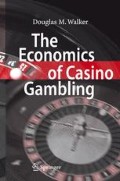Access this chapter
Tax calculation will be finalised at checkout
Purchases are for personal use only
Preview
Unable to display preview. Download preview PDF.
References
The development of gambling from “vice” to accepted entertainment is chronicled by McGowan (2001).
The American Psychiatric Association (APA) estimates that between 1–3% of adults become addicted to gambling (1994, p. 617). There is a significant literature on this issue including the following, cited in Shaffer, Hall, Walsh, and Vander Bilt (1995): Lesieur (1989), Lesieur and Rosenthal (1991), Volberg (1994), and Volberg and Steadman (1988). Also see Eadington (1989, 1993), Goodman (1994a, 1995a), Grinols (1995a), Lesieur and Blume (1987), Shaffer and Hall (1996), Volberg (1996), Volberg and Steadman (1989), and Walker and Dickerson (1996). It is generally accepted that there is a sample of the population that gambles to such an extent that it disrupts their professional or personal lives.
Two such conferences were the Whistler Symposium (2000, Whistler, B.C., Canada), the papers of which were published in Journal of Gambling Studies, 2003; and the 5th Annual Alberta Conference on Gambling Research (2006, Banff, Albert, Canada), papers forthcoming (Williams, Smith, and Hodgins 2007).
Just as objective criteria are useful in estimating the prevalence of pathological gambling, objective criteria are important for the measurement of social costs. Harberger (1971, p. 785) makes this point in the context of welfare economics in general and cost-benefit analyses in particular: “Just as the road-construction standards that a team of highway engineers must meet can be checked by other highway engineers, so the exercise in applied welfare economics carried out by one team of economists should be subject to check by others.”
This definition is given in any text that addresses welfare economics. For other examples, see Just, Hueth, and Schmitz (1982) or Varian (2006).
For related discussions, see Baumol and Oates (1988), Bhagwati (1983), Bhagwati, Brecher, and Srinivasan (1984), Johnson (1991), Krueger (1974), Mueller (1989), Posner (1975), Tollison (1982), and Tullock (1967).
This type of exposition is used by Dixit and Grossman (1984). A slightly more technical presentation would include a discussion of relative prices, input coefficients, and preferences. See any intermediate microeconomics text for more details on the foundations of these models.
Behavior that involves attempts to obtain or prevent wealth transfers is generally referred to as “rent seeking” discussed in more detail in Chap. 7. Also see Johnson (1991) and Mueller (1989) for extensive discussions.
Becker argues that, in the case of a competitive crime market, the value of the resources used in producing locks and paying police can be assumed to approximate the social cost of the crime (1968, p. 171, note 3; italics added).
The amount by which the full cost of a tax exceeds the value of revenues collected is often referred to as the “deadweight loss” or “excess burden” of the tax. Varian (2006, pp. 300–302) provides a (non-technical) graphical and verbal explanation of the deadweight loss from taxes.
Dixit and Grossman (1984) use a similar example but do not show a contraction of the PPF. Carbaugh (2004, Chap. 2) explains that the axes in the PPF model give a scale for output per unit of input resource. Social costs effectively reduce productive capacity (given input endowments) since production is diverted to some other use, which would be unnecessary in the absence of theft.
McGowan (1999) notes this is a utilitarian interpretation of wealth transfers.
For example, see Grinols and Omorov (1996), Grinols and Mustard (2001, 2006), LaFalce (1994), and Thompson (1997).
Seminal work in this area was by Jacob Viner (1931).
The issue is a bit more complicated than the discussion here implies. Whether society’s wealth is reduced by the pollution depends upon whether the pollution is marginally relevant. For a discussion of the importance of marginally relevant externalities, see Barnett and Kaserman (1998).
For more detailed discussions of externalities, particularly the distinction between pecuniary and technological externalities, see Barnett (1978, 1980), Barnett and Bradley (1981), Barnett and Kaserman (1998), and Baumol and Oates (1988, Chap. 3, especially p. 30).
Baumol and Oates (1988, p. 30) write, “the price effects that constitute pecuniary externalities are merely the normal competitive mechanism for the reallocation of resources in response to changes in demand or factor supplies.”
Grinols and Mustard (2001) also illustrate confusion about externalities.
McCormick’s (1998) discussion of “uncompensated social costs” is a useful complement to this section. The private consequences issue is dealt with in more detail by Eadington (2003).
In addition, see “Casinos in Florida” (1995), Tannenwald (1995), and U.S. House (1995).
See Baumol and Oates (1988) for a complete discussion of externalities.
More recent comprehensive studies by NORC (1999) and the NGISC (1999) are similar in this respect.
It is for this reason that their work is scrutinized by Walker and Barnett (1999) and Walker (2003).
At the Whistler Symposium (2000) several psychologists informally told me that the term “psychic cost” is “offensive.” No offense is intended.
See ACIL (1999) on this issue.
Walker (2004) gives the example that a gambler bets an average of $1,000 in order to lose $100 at slot machines with a 90% pay-out.
Grinols and Mustard (2001) resurrect the “abused dollars” concept, but define it differently than Politzer et al. (1985).
See “Casinos in Florida” (1995), Goodman (1995b), Kindt (1994), Politzer et al. (1985), and Thompson et al. (1997).
Rights and permissions
Copyright information
© 2007 Springer-Verlag Berlin Heidelberg
About this chapter
Cite this chapter
(2007). The social costs of gambling. In: The Economics of Casino Gambling. Springer, Berlin, Heidelberg. https://doi.org/10.1007/978-3-540-35104-7_6
Download citation
DOI: https://doi.org/10.1007/978-3-540-35104-7_6
Publisher Name: Springer, Berlin, Heidelberg
Print ISBN: 978-3-540-35102-3
Online ISBN: 978-3-540-35104-7
eBook Packages: Business and EconomicsEconomics and Finance (R0)

